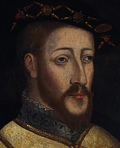 |
James V
b. 10 Apr 1512, Linlithgow, West Lothian [1]
d. c. 14 Dec 1542, Falkland, Fife [2] |
| Title: |
Dei gratia Rex Scotorum = By the grace of God, King of the Scots |
| Term: |
9 Sep 1513 - c. 14 Dec 1542 |
| Chronology: |
9 Sep 1513, succeeded to the throne of Scotland |
|
21 Sep 1513 [?], crowned, Stirling [3] |
|
c. 14 Dec 1542, died |
| Names/titles: |
Baptized (11 Apr 1512): James; private name: James Stewart; Gaelic name: Seumas; Duke of Rothesay [10 Apr 1512 - 9 Sep 1513], Earl of Carrick [10 Apr 1512 - 9 Sep 1513] |
| Biography: |
| Third son of James IV and Margaret Tudor, daughter of Henry VII and sister of Henry VIII, kings of England; became heir apparent as his elder brothers, James (1508) and Arthur (1510), had died by the time of his birth; succeeded his father who was killed in the Battle of Flodden Field (9 Sep 1513); was placed under tutelage of his mother, who appears to have assumed the regency in compliance with James IV's will; after Margaret Tudor privately married Archibald Douglas, 6th Earl of Angus (1514) and the marriage became known, the Privy Council considered that she had forfeited the right to be a regent and invited John Stewart, 2nd Duke of Albany, son of Alexander Stewart, Duke of Albany, and grandson of King James II to return from France for assuming regency; the king continued to be in custody of his mother until the Duke of Albany arrived to Scotland and was acknowledged as Governor and Protector of the Realm by Parliament at Edinburgh (12 Jul 1515 - 16 Nov 1524); was put into custody of the Governor (Aug 1515), who spent most of his time in France (1517-1521, 1522-1523, 1524) and was finally dismissed by an act of Parliament (16 Nov 1524); installed as king by his mother and her adherents at Edinburgh (26 Jul 1524); taken into custody (1525) by his stepfather, Earl of Angus, and remained a virtual prisoner of the Douglases who ruled Scotland for nearly three years; declared to be in possession of full "authority royal" by the Estates assembled in Parliament (14 Jun 1526), but continued to remain in captivity; managed to escape (after 20 May 1528) and began personal rule by breaking the power of the Douglases (forfeited in Parliament 5 Sep 1528); asserted law and order in the Highlands and Borders; established the College of Justice (1532); after a series of intermittent hostilities made peace with England (1534); strengthened alliance with France by marrying Madeleine (1 Jan 1537), daughter of King François Ier, and after her death contracted a marriage with Marie de Lorraine (1538), daughter of Claude duc de Guise; resisted attempts to introduce reformation of the church in Scotland and sanctioned harsh measures, including the burning of the most outspoken heretics; subdued the chiefs of the Scottish Isles (1540); ordered invasion of England which culminated in sound defeat of the Scots at Solway Moss, Cumbria (24 Nov 1542); being mortally sick at the time of the battle, died before or on 14 Dec 1542 at Falkland. |
| Biographical sources: "James V: The Personal Rule 1528–1542", by Jamie Cameron, ed. by Norman Macdougall (East Lothian: Tuckwell Press Ltd., 1998). |
| |
| [1] |
A key source for verifying the date of James's birth is the letter of his father, James IV, to the King of Denmark Hans, where he reports that "On holy Easter Eve, our most beloved spouse was delivered of a son, who was presented at the font on the very day of the Feast of the Lord's Resurrection, and received the sign of baptism from the priest." See "The Letters of James the Fourth, 1505-1513", ed. by Robert Kerr Hannay, Robert Laird Mackie (Edinburgh: Scottish History Society, 1953), 243. In 1512, the Easter fell on 11 Apr 1542 and the "holy Easter Eve" might be interpreted as Saturday, 10 Apr 1542. |
| [2] |
The death of James V has been variously assigned by contemporary and later sources to 25 Nov 1542, 12 Dec 1542, 13 Dec 1542, 14 Dec 1542, 15 Dec 1542, 16 Dec 1542, and 20 Dec 1542, and to the latter end of December 1542. Thorough analysis of the sources is found in Dunbar (1906), 240-243. Although Dunbar arrives at concluding that James died "at Falkland, on Thursday the 14th of December 1542", the issue remains open to discussion. |
| [3] |
"The History of Scotland, from the Death of King James I, in the year M.CCCC.XXXVI to the Year M.D.LXI", by John Lesley Bishop of Ross (Edinburgh, 1830), p. 97: "... at Striuelinge ... apoun the xxj day of September 1513, ... wes crownit King..."; "The History of Scotland from the Earliest Period to the Present Time", by George Buchanan (Glasgow, Edinburgh, London: Blackie and Son, 1856), vol. II: Stirling, 22 Feb 1514; "Dictionary of National Biography", Volume 29: "... but it probably took place at Scone in presence of the general council which met at Perth before 19 Oct. and sat till at least 26 Nov. 1513, when the French ambassadors, <...>, presented letters from Louis XII."
|
|
Image: portrait by unknown artist. |